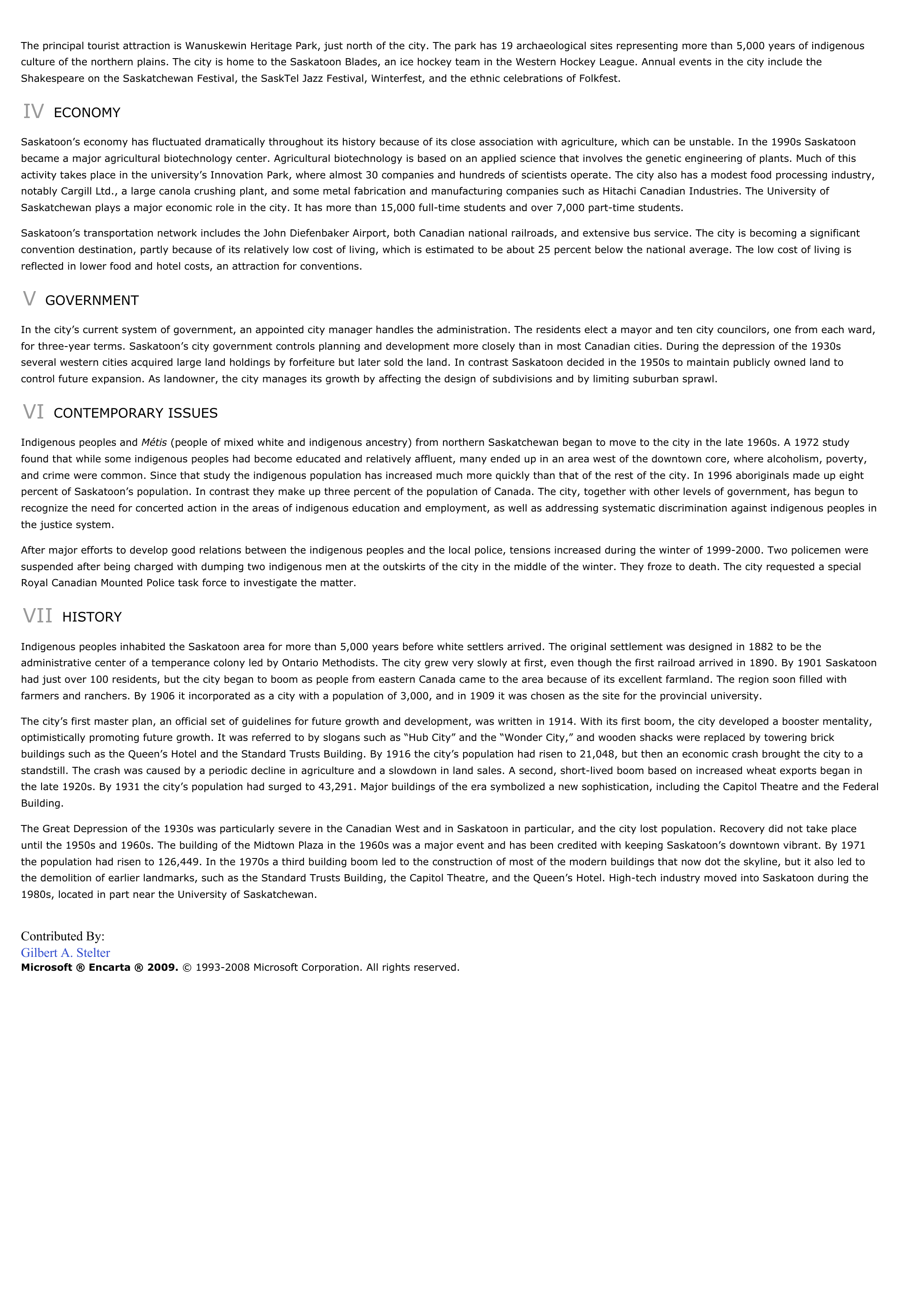Saskatoon - geography.
Publié le 26/05/2013

Extrait du document
«
The principal tourist attraction is Wanuskewin Heritage Park, just north of the city.
The park has 19 archaeological sites representing more than 5,000 years of indigenousculture of the northern plains.
The city is home to the Saskatoon Blades, an ice hockey team in the Western Hockey League.
Annual events in the city include theShakespeare on the Saskatchewan Festival, the SaskTel Jazz Festival, Winterfest, and the ethnic celebrations of Folkfest.
IV ECONOMY
Saskatoon’s economy has fluctuated dramatically throughout its history because of its close association with agriculture, which can be unstable.
In the 1990s Saskatoonbecame a major agricultural biotechnology center.
Agricultural biotechnology is based on an applied science that involves the genetic engineering of plants.
Much of thisactivity takes place in the university’s Innovation Park, where almost 30 companies and hundreds of scientists operate.
The city also has a modest food processing industry,notably Cargill Ltd., a large canola crushing plant, and some metal fabrication and manufacturing companies such as Hitachi Canadian Industries.
The University ofSaskatchewan plays a major economic role in the city.
It has more than 15,000 full-time students and over 7,000 part-time students.
Saskatoon’s transportation network includes the John Diefenbaker Airport, both Canadian national railroads, and extensive bus service.
The city is becoming a significantconvention destination, partly because of its relatively low cost of living, which is estimated to be about 25 percent below the national average.
The low cost of living isreflected in lower food and hotel costs, an attraction for conventions.
V GOVERNMENT
In the city’s current system of government, an appointed city manager handles the administration.
The residents elect a mayor and ten city councilors, one from each ward,for three-year terms.
Saskatoon’s city government controls planning and development more closely than in most Canadian cities.
During the depression of the 1930sseveral western cities acquired large land holdings by forfeiture but later sold the land.
In contrast Saskatoon decided in the 1950s to maintain publicly owned land tocontrol future expansion.
As landowner, the city manages its growth by affecting the design of subdivisions and by limiting suburban sprawl.
VI CONTEMPORARY ISSUES
Indigenous peoples and Métis (people of mixed white and indigenous ancestry) from northern Saskatchewan began to move to the city in the late 1960s.
A 1972 study found that while some indigenous peoples had become educated and relatively affluent, many ended up in an area west of the downtown core, where alcoholism, poverty,and crime were common.
Since that study the indigenous population has increased much more quickly than that of the rest of the city.
In 1996 aboriginals made up eightpercent of Saskatoon’s population.
In contrast they make up three percent of the population of Canada.
The city, together with other levels of government, has begun torecognize the need for concerted action in the areas of indigenous education and employment, as well as addressing systematic discrimination against indigenous peoples inthe justice system.
After major efforts to develop good relations between the indigenous peoples and the local police, tensions increased during the winter of 1999-2000.
Two policemen weresuspended after being charged with dumping two indigenous men at the outskirts of the city in the middle of the winter.
They froze to death.
The city requested a specialRoyal Canadian Mounted Police task force to investigate the matter.
VII HISTORY
Indigenous peoples inhabited the Saskatoon area for more than 5,000 years before white settlers arrived.
The original settlement was designed in 1882 to be theadministrative center of a temperance colony led by Ontario Methodists.
The city grew very slowly at first, even though the first railroad arrived in 1890.
By 1901 Saskatoonhad just over 100 residents, but the city began to boom as people from eastern Canada came to the area because of its excellent farmland.
The region soon filled withfarmers and ranchers.
By 1906 it incorporated as a city with a population of 3,000, and in 1909 it was chosen as the site for the provincial university.
The city’s first master plan, an official set of guidelines for future growth and development, was written in 1914.
With its first boom, the city developed a booster mentality,optimistically promoting future growth.
It was referred to by slogans such as “Hub City” and the “Wonder City,” and wooden shacks were replaced by towering brickbuildings such as the Queen’s Hotel and the Standard Trusts Building.
By 1916 the city’s population had risen to 21,048, but then an economic crash brought the city to astandstill.
The crash was caused by a periodic decline in agriculture and a slowdown in land sales.
A second, short-lived boom based on increased wheat exports began inthe late 1920s.
By 1931 the city’s population had surged to 43,291.
Major buildings of the era symbolized a new sophistication, including the Capitol Theatre and the FederalBuilding.
The Great Depression of the 1930s was particularly severe in the Canadian West and in Saskatoon in particular, and the city lost population.
Recovery did not take placeuntil the 1950s and 1960s.
The building of the Midtown Plaza in the 1960s was a major event and has been credited with keeping Saskatoon’s downtown vibrant.
By 1971the population had risen to 126,449.
In the 1970s a third building boom led to the construction of most of the modern buildings that now dot the skyline, but it also led tothe demolition of earlier landmarks, such as the Standard Trusts Building, the Capitol Theatre, and the Queen’s Hotel.
High-tech industry moved into Saskatoon during the1980s, located in part near the University of Saskatchewan.
Contributed By:Gilbert A.
StelterMicrosoft ® Encarta ® 2009. © 1993-2008 Microsoft Corporation.
All rights reserved..
»
↓↓↓ APERÇU DU DOCUMENT ↓↓↓
Liens utiles
- Saskatoon - Geography.
- Tokyo - geography.
- Toronto - geography.
- Venice (Italy) - geography.
- Vienna - geography.

































